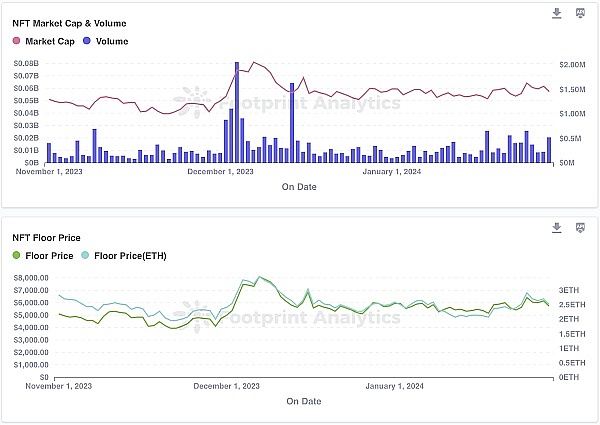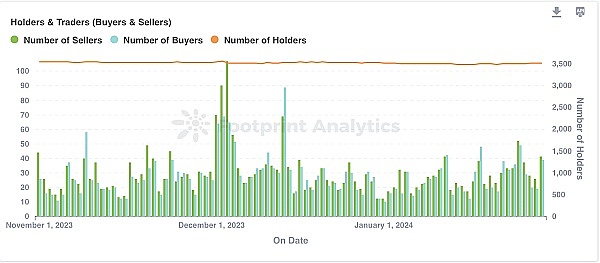Author: stella@footprint.network, compiler: ming@footprint.network, data source : Milady Maker NFT Collection Dashboard
The Milady Maker Collection includes 10,000 algorithmically generated personal NFTs, each featuring neochibi art style influenced by street fashion culture. Will this NFT project rise in 2024?
About Milady Maker
Milady Maker NFT showcases a unique series of 10,000 Personal Pictures (PFP) NFTs minted on the Ethereum blockchain , and is known for its neochibi aesthetic. The collection draws inspiration from the exotic and vibrant Tokyo street fashion of the 2000s, with each avatar sporting a random outfit that highlights personality and fashion prowess. Milady avatars were created to represent a fusion of trendsetting style and community engagement, showcasing a uniquely stylized digital universe. Despite its artistic intent, the series sparked mixed reactions, with some praising its innovative approach to digital art while others had reservations, labeling it one of the more controversial designs in the PFP NFT space. one.
The team behind Milady Maker
The Milady Maker NFT series was conceived by Remilia Collective, with Charlotte Fang serving as lead designer and contributing to the project’s unique aesthetic contribute. The series suffered a slump in 2022 amid controversy, but has regained its footing after she distanced herself from the project. Remilia Collective is a decentralized autonomous organization (DAO) known for its roots in New York’s Gen Z art scene, championing an avant-garde, counter-mainstream ethos that is reflected in the unique style of the Milady Maker NFT.
Milady Maker NFT series data
In the ever-changing Web3 world, Understanding non-fungible tokens (NFTs) is like exploring a vast, unknown ocean. Data analysis is a tool that helps find direction for everyone involved, such as collectors, investors, and creators. It does this by carefully looking at transaction records, ownership transitions, price movements, and user interactions with NFTs. This information helps people make informed choices, avoid risks, and discover new opportunities in the NFT market.
Having guidance like this is critical to staying on track in the ever-changing NFT landscape. It helps make choices that are in sync with the market, ensuring no one gets lost in the massive NFT data.
NFT market trends
The NFT market is a dynamic ecosystem, and data indicators are like a barometer to measure its changes. Key indicators such as market capitalization, trading volume, floor price and trading market activity help us analyze the health and growth potential of this field.
Those investors who can grasp market trends can predict the direction of the trend, manage investment risks, and discover hidden opportunities. This data is important as the foundation for a smart investment plan and a line of defense against the ups and downs of the NFT market.

Source: Milady Maker NFT - Market Cap, Volume and Floor
Footprint Analytics NFT Data shows that in the past 90 days, the floor price and market value of the Milady Maker NFT series have fluctuated significantly.
User Behavior
In the NFT field, user behavior data such as total sales volume, total number of buyers and sellers, unique holders and daily transactions are provided. A microscopic view of user behavior. Indicators such as daily sales volume, transaction volume, and fluctuations in the number of holders, sellers, and buyers provide real-time insights into the pulse of the market.
Analyzing this user behavior data gives NFT participants a deeper understanding of market sentiment and participant activity. Trends such as peak buying periods, shifts in holder sentiment, and the emergence of buying and selling pressure can be identified. By leveraging this intelligence, investors and creators can refine their strategies to align with market demand and stay ahead of the ever-changing world of NFTs.

Source: Milady Maker NFT - Daily Holders, Sellers and Buyers
The latest NFT data from Footprint Analytics shows that as of January 29, 2024, the number of Milady Maker NFT holders has stabilized at around 3,500. The current holder to supply ratio is 2.84.
 JinseFinance
JinseFinance
 JinseFinance
JinseFinance JinseFinance
JinseFinance JinseFinance
JinseFinance JinseFinance
JinseFinance Brian
Brian Bitcoinist
Bitcoinist Coindesk
Coindesk Cointelegraph
Cointelegraph Bitcoinist
Bitcoinist Bitcoinist
Bitcoinist